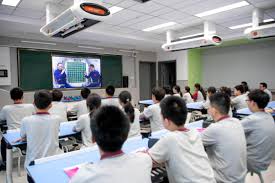Foreign
A thousand days in space: China’s space station harvests a bounty of achievements

By Liu Shiyao, People’s Daily
On Dec. 31, 2022, Chinese President Xi Jinping solemnly declared in his 2023 New Year Address that “China’s space station was fully completed.”
Today, the space station has been operating smoothly and safely for more than 1,000 days. It has accommodated seven astronaut crews and facilitated over 200 space science and application projects, showcasing China’s strength of self-reliance and independent innovation in science and technology.
This scene inside the space station is common: astronauts floating to the center of the cabin to do a stylish pull-up using ceiling handrails, riding the space bicycle, or running on the treadmill. The station is equipped with a dedicated exercise area to help astronauts maintain muscle strength and reduce the impact of long-term microgravity exposure on the body.
Over the past 1,000 days, the space station’s environment and facilities have been continuously improved. Equipment such as fitness devices have been regularly delivered to the space station.
According to Tang Yi, a researcher from the ground support team of the space station and the China Academy of Space Technology, China’s space station uses the latest generation of commercial wireless communication technology to ensure stable and seamless communication both inside and outside the cabin.
“To help astronauts sleep better, we replaced the doors of the sleeping area,” said Tang. “The new doors use improved materials, structure, and locking design, achieving better sound and light insulation.”
The space station is also home to a unique group of “AI crewmates”. AI assistants such as the Wukong AI large language model, pipeline inspection robots, and Xiaohang robot provide intelligent and specialized support for astronauts in orbit.
Tang noted that in the next 1,000 days, the team hopes to introduce more advanced scientific and technological innovations to further enhance the station’s intelligence and autonomy, enabling it to better support astronauts’ work and life in space.
The space station serves scientific application, and scientific experiments are carried out in it every day.
Astronauts have taken video footage of sprouting Arabidopsis seedlings to study how microgravity affects plant cell structure and function. They also conduct experiments on brain organoid chips to explore how the space environment impacts human brain health.
According to Guo Xiaoxiao, deputy director of the application office at the Technology and Engineering Center for Space Utilization of the Chinese Academy of Sciences, space science and application projects can be broadly categorized into three areas: scientific research in fields such as space life science and biotechnology, space materials science, microgravity fundamental physics, microgravity fluid physics and combustion, and new spacecraft technologies; emerging scientific projects featuring innovation and frontier exploration; and application-oriented payload missions.
“Overall, these experimental projects have progressed very smoothly,” said Guo. “In some areas of fundamental science, the results have even exceeded scientists’ expectations, bringing many surprises.”
Beyond the orbiting space station, there are actually two more “space stations” on Earth.
One is an identical ground-based version built by China Aerospace Science and Technology Corporation to enable full technical validation for the station’s design, construction, and in-orbit operation, providing essential support for the real space station.
The other is a “digital space station” that offers simulation and verification support through pre-mission simulation, in-mission digital co-flight, and post-mission status evaluation.
Together, these three elements — the space-based, ground-based, and digital systems — form an integrated operational framework, providing robust support for the long-term, stable operation of China’s space station.
Tang explained that the ground support team continues to maintain an “around-the-clock, 365 days × 24 hours” standby mode, responsible for data monitoring, trend analysis, mission support, and troubleshooting.
Looking to the next 1,000 days, leveraging the role of the space station as a “space home port” will be an important direction of exploration.
The station has unique advantages — abundant resources, continuous human presence, and a high level of intelligence, said Tang. By developing standardized service models and interfaces, and providing in-orbit services for various types of spacecraft, China’s space station is poised to embrace even broader prospects for development.
Foreign
Understanding China’s urban development through a Chinese perspective

By Wu Yan, People’s Daily
From the ancient wisdom in Kaogong ji, or The Artificer’s record, the earliest Chinese book on technologies which describes how craftsmen build the state, to the Athens Charter that defines the functions of a modern city, humanity’s pursuit of the ideal city has spanned millennia.
China’s current efforts to build people-centered smart cities, aligned with the vision of making cities better places to live, reveal distinctive perspectives on urban development.
The first lies in its foundational philosophy: Cities are built by and for the people defines the essence of China’s approach to urban modernization.
In Shanghai’s Xuhui Riverside, foreign expert Kseniia Kirianaki observed how prime riverfront area was preserved as public space rather than becoming commercial or luxury residential zones. It’s truly remarkable, she said.
From building twin hills in the city center based on citizens’ suggestions to building apartment blocks for food delivery riders, Shanghai consistently prioritizes people in its planning, reserving premium resources for the public use and ensuring equitable access to services. The people’s city ethos shines vividly here.
Nationally, cities embrace this same principle. Beijing has implemented detailed underground space development plans, while Guangzhou expands its network of public cultural facilities.
Urban planning now begins with residents’ actual needs; city construction emphasizes livability and employment; governance fosters collective participation and shared benefits. Though cities express this warmth differently, all share the core commitment: only by building foundations for better lives can citizens’ sense of fulfillment, happiness, and security truly flourish.
The second perspective is evident in practice. China’s pursuit of high-quality, connotative urban development is charting a new course for people-oriented modernization.
Visitors to Chongqing’s digital urban operations center witness firsthand how integrated data systems underpin city management. In Fuzhou’s a historical and cultural area Sanfang Qixiang, which literally means three lanes and seven alleys, urban renewal has both preserved the city’s cultural heritage and improved residents’ quality of life. Similarly, Nanjing’s Tangshan Quarry Park exemplifies ecological restoration, transforming a former mining site into a thriving public green space – turning industrial scars into recreational havens.
These cases illustrate the compelling demonstration effect of China’s high-quality urban development. As UN Under-Secretary-General Anaclaudia Rossbach noted, China’s experience offers valuable insights globally.
China’s cities have shifted from large-scale expansion to improving quality and efficiency, emphasizing intensive growth over extensive development. By focusing on the construction of modern cities of the people that are innovative, desirable to live in, beautiful, resilient, culturally advanced, and smart, China is refining its urban vision. This approach seeks efficient, distinctive, and well-coordinated progress to enhance the overall quality of urban life.
The third perspective lies in its global influence. China demonstrates its sense of responsibility by providing international public goods.
Take the concept of the 15-minute community life circle as an example. First proposed by Shanghai at the inaugural World Cities Day Forum in 2014, the concept quickly spread across the country. Later, Paris introduced its own 15-minute city plan, and Milan has been described by media as one of the cities closest to achieving that vision. This resonance shows how China’s ideas are inspiring global urban innovation.
China’s contributions go beyond concepts. The Shanghai Award has become a high-level UN recognition for urban sustainability achievements. The Shanghai Manual remains among the most downloaded publications from UN-Habitat , and the Shanghai Index is being piloted in cities across multiple countries. These efforts offer new solutions to urbanization challenges and highlight China’s responsibility and contribution as a major country.
Today’s China is committed to building a collaborative social governance system with broad participation, aiming to deliver benefits for all. The goal is to make cities true homes of happiness for their residents and ensure development brings tangible improvements to everyday life. This commitment resonates with historical aspirations while representing a significant contribution to global urban civilization.
Foreign
Spring manufacturer in E China finds its bounce on new track of growth

By Liu Junguo, People’s Daily
Recently, Le Zhiguo, head of the robotics spring task force at Zhejiang Meili High Technology Co., Ltd. (Meili), visited several humanoid robot companies, including Unitree Robotics and Deep Robotics.
“Our purpose was to deliver prototype springs and deepen collaboration with downstream partners to jointly overcome technical hurdles,” stated Le.
Le explained that while many humanoid robot developers concentrate on core components like control systems (“brain”), motion coordination (“cerebellum”), and joint actuators, they often pay less attention to the flexibility of the body and limb systems. This oversight can result in operational issues such as overheating joints, unnatural movements, and reduced durability.
Recognizing this gap, Meili leveraged its expertise to assist. The company has already begun supplying small batches of prototype springs to several humanoid robot manufacturers. The solution for enhancing robotic flexibility and agility? A specialized spring, approximately one centimeter in diameter.
At first glance, this component may appear similar to conventional springs. “However,” Le clarified, “its strength and precision are significantly higher. When integrated into linear actuators, it enables smoother and more coordinated robotic movements.”
Le Zhiguo drew an analogy: if sensors provide a robot’s sense of touch and harmonic reducers function as its joints, then these high-precision, high-strength damping springs act like ligaments. They cushion joints, facilitate posture adjustment, and mitigate vibration and noise.
To accelerate this development, Meili established a dedicated robotics spring team earlier this year, drawing key technical experts from more than 120 R&D personnel. Within just three months, the team progressed from concept design to small-batch production, enabling Meili to supply springs to both domestic and international robotics companies.
How did the company manage to springboard into this new field so quickly?
“The foundation was built on over 35 years of experience in the spring industry,” explained Zhang Bihong, Founder and Chairman of Meili. “That solid expertise made our entry into a new sector possible.”
Founded in Ru’ao township, Xinchang county, east China’s Zhejiang province, Meili began as a small spring workshop. “We started by manufacturing springs for fire extinguishers, then progressed to motorcycle valve springs,” Zhang recalled.
In the early days, with few clients, Zhang often rode his bicycle along dusty country roads, visiting motorcycle parts factories one by one. Gradually, the company expanded into the automotive spring market.
In recent years, intensifying competition in the traditional spring market could no longer support the company’s growth ambitions. However, the rapid rise of China’s new energy vehicle (NEV) sector presented a new opportunity.
“To thrive, we had to ascend the value chain,” Zhang stated. Determined to move into higher-value products, he led the company to develop air suspension springs for NEVs – a segment with significantly higher technical barriers.
Air suspension systems, once exclusive to high-end vehicles, were long dominated by foreign companies. Despite having no prior experience in this field, the Meili team recognized that the market opportunity might be fleeting. The pressure to succeed was immense.
“The greatest challenge was improving the durability and air-tight sealing between the rubber airbag and the metal components. Both factors directly impact product quality,” said Li Xiaojun, head of the air spring project team.
“Another difficulty was ensuring stable performance under extreme conditions. Sometimes, lab data looked perfect, but during real vehicle tests, the damping materials failed to meet standards,” Li added.
“To enhance air-tightness and ensure the springs could withstand fatigue, heat, and cold, we tested more than 100 types of rubber materials,” Li explained. The team repeatedly refined designs, adjusted material formulas, optimized vulcanization processes, and tested structural options. After enduring 5.42 million cycles in rigorous alternating high- and low-temperature humidity tests, Meili successfully produced its first prototype air spring for passenger vehicles in 2024. The prototype passed customer validation later that year.
The company continues to innovate. “Robot springs offer even higher added value than automotive springs and could represent a new multi-billion-yuan market,” Zhang noted.
Through relentless innovation, this small component is springing into a world of broader possibilities.
Foreign
Three products that reveal China’s secret in exploring new frontiers of growth

By Li Hongxing, People’s Daily
Two recent developments in wind turbine blade technology have sparked considerable public interest. First, blade lengths have increased dramatically – from just over 30 meters to more than 150 meters – significantly boosting the power-generating capacity of individual turbines. Second, companies are pioneering innovative ways to recycle decommissioned blades, particularly those from the first generation of turbines now nearing the end of their service life. These retired blades are being transformed into eco-friendly products such as pallets and pedestrian walkways.
As blades grow longer and industry chains expand, new commercial models and development trajectories are emerging. During a recent visit to a blade manufacturing facility, a striking question arose as we stood before a massive 100-meter blade in production: “If blades keep getting larger and production volumes increase, won’t the market eventually become saturated? Where will future growth come from?”
A company representative expressed no such concerns. The firm had already mapped out a comprehensive post-production value chain, covering areas such as turbine operations, maintenance, and blade recycling – each representing a substantial market opportunity in its own right. This strategic expansion and diversification of business models demonstrates how companies are innovating to overcome perceived market limitations and sustain growth.
This raises a broader question: Markets exist – but how can companies access new growth opportunities? Instructive parallels can be drawn from three diverse products across different sectors.
Consider, for instance, the case of bottled water.
In the western mining area of Shuangyashan Mining Company in northwest China’s Heilongjiang province, high groundwater levels once posed serious challenges to coal mining. Guided by a commitment to green development and supported by technological innovation, the company implemented a “drain – purify – reuse” model. The purified water now serves multiple purposes: production processes, dust suppression, irrigation, and even a new mineral water product line. This initiative generates nearly 10 million yuan ($1.41 million) in annual revenue, transforming what was once hazardous mine water into a source of green vitality.
The question remains: Where is the market? Growth emerges through transformation. Whether upgrading traditional sectors or reshaping emerging ones, companies that refuse to settle and persistently pursue improvement and innovation discover new pathways with every problem solved and unlock fresh potential with every reform.
Development resembles digging a well, and the market is the spring: those willing to explore new directions and apply fresh thinking to familiar territory will always find a steady flow of opportunity.
Consider the case of a bus route. Recently, Shanghai J.Y Ba-Shi Passenger Transport (Group) Co., Ltd. launched a customized service enabling elderly passengers to travel directly to local food markets. This “food-focused” route has become a new offering supporting leisure and consumption. As high-speed rail expands and traditional long-distance coach services decline, tailored routes like these have gained popularity across the Yangtze River Delta. Their success lies in accurately identifying consumer needs, carefully designing routes, improving service quality, and strengthening stakeholder collaboration.
Where do such opportunities originate? They require attention to both regional trends and granular shifts. Young and old alike cherish the small joys of everyday life and appreciate accessible escapes close to home. When companies understand and meet these emotional needs, they tap into hidden market potential. Experience shows that through market-driven integration of cultural tourism, local products, and transportation resources, localized demand can become a growth driver, and regional micro-circulation can stimulate broader economic flows.
Finally, consider a screen protector. A company in central China’s Hunan province produces tempered glass screen protectors sold in 68 countries and regions, capturing 30% of the global market. Their competitive edge? Take fingerprint recognition sensitivity: through sustained R&D, they reduced protective film thickness from 0.33 millimeters to just 0.1 millimeters. By refining technology and strengthening their product, they generated tangible growth momentum.
The key lies not only in external drivers but in building inherent capabilities. From a single company to an entire region – and indeed, in forging a new development paradigm – continuous enhancement of internal resilience unlocks greater vitality. The stronger a company’s self-driven strength, the more competitive it becomes. When countless market entities thrive, they inject lasting momentum into China’s high-quality development.
China’s economy possesses a stable foundation, numerous advantages, remarkable resilience, and vast potential. The fundamental conditions and long-term positive trajectory supporting its growth remain unchanged.
Within transformation lies opportunity;in microeconomic circulation, hidden potential; through inner strength, sustainable growth. Rooted in practical experience and looking ahead, China is steadily opening new frontiers for development.
-

 Uncategorized5 years ago
Uncategorized5 years agoFG, states urged to harness flooding for ranching, others with technology – Agbaje
-

 Headlines10 years ago
Headlines10 years agoBreaking: EFCC seals Borno House of Assembly, as Hon members take to their heels
-

 News11 years ago
News11 years agoNigeria Security Operatives Stage Manhunt For Homosexual Perpetrator
-

 News9 years ago
News9 years agoHow 21-year-old Girl fled community over accusation of lesbianism
-

 News10 years ago
News10 years agoYobe Gov Moves Against Deputy
-

 Opinion7 years ago
Opinion7 years ago7 signs she has friend zoned you
-
Technology4 years ago
Online job placement company headhunts women
-

 Headlines9 years ago
Headlines9 years agoBorno Dep Gov Abducts Another Church Leader





